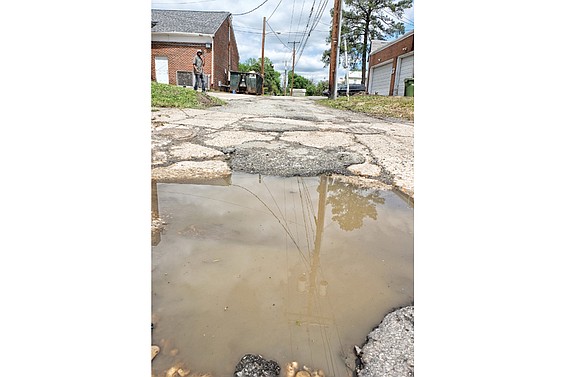Alley blitz underway to fill potholes
Jeremy M. Lazarus | 5/2/2017, 8:56 a.m.
Some of the worst alleys in the city are about to get a facelift.
The Richmond Department of Public Works this week unleashed a new alley blitz to redo 1,300 alleys from Church Hill to Walmsley Boulevard in South Side and Highland Park in North Side to the Museum District in the West End.
The department was allocated $700,000 from a 2015-2016 budget surplus to undertake this new effort, according to Bobby Vincent, interim Public Works director.
This is the first big effort to address alley conditions since 2015, when the first alley blitz was conducted, he said.
It is part of a stepped up effort by City Hall to address some of the issues that impact residents, including potholes and grass mowing in public places, such as parks, schools and street medians, he said.
On the alley front, Mr. Vincent said the money would allow Public Works to have four crews, each with six people, working on the operation.
“Without that new money, we’d only have one crew,” he said, leaving residents grumbling about the poor conditions of alleys that are keys to trash collection and rear access to properties.
Richmond has about 3,000 alleys, with the heaviest concentrations in the older sections of North Side and Church Hill. It has been difficult for the city to keep streets patched, so alleys have long taken a backseat.
During the three-month blitz, crews will grade and spread gravel over most of the 1,300 alleys to be done. They represent about 43 percent of the total number of alleys in the city.
Work, which was to have started on Monday now that leaf collection has ended, was delayed by the rain. However, the blitz was to be in full swing as of Thursday, April 27.
He also received an extra $400,000 from the 2016 surplus to step up grass mowing on city and school property — a major challenge given a shortage of money.
During the March to November mowing season in 2016, Public Works fell behind in part because of rain and because of a shortage of funding, he said.
The new money will enable Public Works to hire 20 temporary workers and nearly double the pace of mowing.
Depending on the weather, he said staff would be able to mow parks every two weeks and school property every three weeks.
He estimated that it requires 100,000 man hours to mow the city’s public acreage. Until the infusion of cash, he said he had enough staff only to do 20,000 to 30,000 man hours of work. The new money, he said, would mean the department will be able to do 50,000 man hours of work.
Mowing is done on a schedule, he said, with his staff seeking to mow popular areas where events and weddings are held every 10 days and parks every two weeks. Other property is mowed every three weeks.
“We do the best we can with the money that is appropriated,” he said.
Separately, he said Public Works completed a three-week pothole blitz last Friday, filling a total of 2,500 potholes in city streets created mostly by winter freeze-and-thaw conditions. During the blitz, the city had six to seven crews at work.
Mr. Vincent said this was a small fraction of the 20,000 potholes that he expects the three regular crews to fill during the year.
On street paving, he said the department also is trying new techniques to keep the asphalt from breaking up.
For example, he cited the stretch of Chamberlayne Avenue between Interstate 95 and School Street, which recently needed repaving after just six years.
He said the street has a concrete base, which expands and contracts and breaks up asphalt. He said this time, fabric was laid over the concrete before the asphalt was laid in an effort to reduce splits and breaks between the concrete base and the asphalt topping. If it works, the life of the asphalt could be extended to 10 to 15 years, he said.







